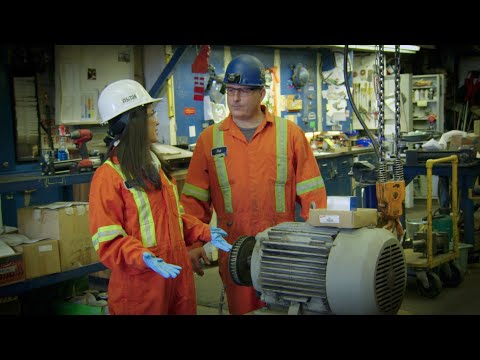Career Overview
Construction millwrights and industrial mechanics install, maintain, troubleshoot, overhaul and repair stationary industrial machinery and mechanical equipment. This unit group includes industrial textile machinery mechanics and repairers.
Construction millwrights:
- Are employed by millwrighting contractors
Industrial mechanics:
- Are employed by manufacturing plants, utilities and other industrial establishments
People in these occupations:
- Have a mechanical aptitude, enjoy working with machinery and possess strong trouble shooting skills
- Follow procedures closely when adjusting machinery or installing new equipment
- Should have good eye-hand coordination, strength and agility
- Should also be able to work well both independently and as part of a team
- Should have strong communication skills
Job Titles
Duties
Construction millwrights and industrial mechanics perform some or all of the following duties:
- Read blueprints, diagrams and schematic drawings to determine work procedures
- Install, align, dismantle and move stationary industrial machinery and mechanical equipment, such as pumps, fans, tanks, conveyors, furnaces and generators according to layout plans using hand and power tools
- Operate hoisting and lifting devices such as cranes, jacks and tractors to position machinery and parts during the installation, set-up and repair of machinery
- Inspect and examine machinery and equipment to detect and investigate irregularities and malfunctions
- Install, troubleshoot and maintain power transmission, vacuum, hydraulic and pneumatic systems, and programmable logic controls
- Adjust machinery and repair or replace defective parts
- Run machine tools such as lathes and grinders to make parts required during overhaul, maintenance or set-up of machinery
- Clean, lubricate and perform other routine maintenance work on machinery
- Build foundations for machinery or direct other workers to build foundations
- Assemble machinery and equipment prior to installation using hand and power tools and welding equipment
Earnings
Earnings is income that workers receive in exchange for their labour. Depending on the type of employment, earnings can be in the form of wages (hourly), salaries (fixed monthly or annual) or self-employed earnings.
Work Environment
# Workers Employed
6,630% Employed Full Time
70%Millwrights and industrial mechanics typically work 40 hours per week. Shift work is common and employees may need to work on call in order to respond to machinery breakdowns. In addition, workers may be required to temporarily relocate to remote locations.
Millwrights and industrial mechanics work inside manufacturing facilities, where the environment is often noisy and dirty. They may also work outside, where workers are exposed to weather. As well, workers may work at heights from ladders and scaffolds or in cramped spaces.
Workplace hazards include moving machinery, falling objects and potential falls from heights. As a result, millwrights and industrial mechanics must be fully trained in safety procedures.
Career Pathways
Millwrights and industrial mechanics work in closely related occupations. While employed in one occupation, workers may learn some of the skills and techniques of the other. This provides a high degree of employment flexibility.
Additionally, workers may be cross-trained in a second, related trade, such as pipefitting, welding, machining or electrical maintenance. With experience, workers can advance to supervisory positions or start their own businesses.
Occupational Interests
It’s important to understand what kinds of occupations align with your interests.
For more about occupational interests visit Skills for the Future Workforce > Characteristics.
Here are the top occupational interest(s) for this career profile:
Education, Training and Skills
Completion of Grade 10 or equivalent (including English 10, Mathematics 10, Science 10) is the minimum education requirement; however, completion of secondary school is preferred. Other beneficial qualifications include:
- Completion of a three- to four-year apprenticeship program (or a combination of more than three years work experience in the trade and some college or industry courses) for certification by SkilledTradesBC
Certification is not mandatory in B.C., but it can offer more well-rounded training and will likely increase work opportunities. Millwright and industrial mechanic apprenticeships:
- Can be started in secondary school, through entry-level training at colleges and technical institutes, or by direct entry to the workforce
- Require workers to find a sponsor employer who is willing to participate in the program
Millwrights and industrial mechanics are eligible for Inter-provincial Standard Endorsement (Red Seal) qualification through SkilledTradesBC, which allows holders to work in any province or territory. Once individuals pass the final examination of their accredited training program, they will achieve certification and will automatically receive a Red Seal endorsement.
Workers with 9,900 hours of documented, directly related work experience who have not entered an apprenticeship program may obtain certification by passing a challenge exam administered by SkilledTradesBC. For more information please see the SkilledTradesBC website at www.skilledtradesbc.ca
Industrial mechanics who are certified for that occupation by a regulator elsewhere in Canada can apply for the same certification from the regulator in B.C. Under the terms of the Canadian Free Trade Agreement (CFTA), most applicants who are transferring their credentials from elsewhere in Canada will not be required to complete additional training or testing. However, the B.C. regulator may ask applicants to provide further information such as a letter of good standing, references, or criminal record check.
For those who trained outside of Canada and never received certification from any Canadian jurisdiction, a full assessment is likely needed. Most occupational regulators have a process for assessment and recognize internationally trained applicants.
Contact SkilledTradesBC for details on how to apply for certification in B.C.
For information about labour mobility in Canada, visit www.workersmobility.ca.
View a list of Professional Regulatory Authorities in B.C.
Trades training resources
Visit our trades training page at www.workbc.ca/trades to learn about apprenticeship and trades training in B.C.
Education programs in B.C.

Top Skills
Every job calls for a certain set of skills. Knowing those skills is the first step in finding a good career fit.
Here, you will find the 10 most relevant workplace skills. Some are more important to achieving success in a certain career than others. These skills may come naturally to you or you may need to gain them through education, training and experience.
See the list of work-related skills below, ranked in order of importance for this career. Check out the list and see if this career matches your skills—take that first step!
Performing routine maintenance on equipment and determining when and what kind of maintenance is needed.
Determining causes of operating errors and deciding what to do about it.
Repairing machines or systems using the needed tools.
Watching gauges, dials or other indicators to make sure that a machine is working properly.
Using logic and reasoning to identify the strengths and weaknesses of alternative solutions, conclusions or approaches to problems.
Controlling operations of equipment or systems.
Conducting tests and inspections of products, services or processes to evaluate quality or performance.
Keeping track of and assessing your performance, other individuals, or organizations to make improvements or take corrective action.
Being able to solve novel, ill-defined problems in complex, real-world settings.
Giving full attention to what other people are saying, taking time to understand the points being made, asking questions as appropriate, and not interrupting at inappropriate times.
Labour Market Statistics
Discover data, facts and information that have been gathered and analyzed. Learn about the characteristics of the economy and labour market in B.C.
Employment
Find out about employment types and trends by region and industry.
Employment
6,630Employment by Region







| Region | Employment | % Employment of this Occupation |
|---|---|---|
| Cariboo | 835 | 12.6% |
| Kootenay | 565 | 8.5% |
| Mainland/Southwest | 2,610 | 39.4% |
| North Coast and Nechako | 395 | 6.0% |
| Northeast | 360 | 5.4% |
| Thompson-Okanagan | 1,190 | 18.0% |
| Vancouver Island/Coast | 675 | 10.2% |
Labour Market Outlook
The B.C. Labour Market Outlook is a 10-year forecast of the expected supply and demand for labour in the province. It’s usually updated every year. The purpose is to provide British Columbians with the knowledge to make informed decisions on careers, skills training, education and hiring.
Forecasted Job Openings (2025-2035)
2,760Forecasted Job Openings
Forecasted Employment Growth Rate
Composition of Job Openings
Job Openings by Region (2025-2035)







| Region | Job Openings | Avg. Annual Employment Growth |
|---|---|---|
| Cariboo | 240 | -0.4% |
| Kootenay | 220 | -0.1% |
| Mainland/Southwest | 1,150 | 0.8% |
| North Coast and Nechako | 130 | 0.0% |
| Northeast | 150 | 0.6% |
| Thompson-Okanagan | 570 | 0.7% |
| Vancouver Island/Coast | 300 | 0.5% |
Industry Highlights
Learn about the opportunities in B.C.'s major industries, including employment trends, earning potential, locations of work and more.
Forecasted Job Openings by Industry
| Industry | Job Openings (2025-2035) |
|---|---|
| Manufacturing | 1,100 |
| Mining and Oil and Gas Extraction | 470 |
| Construction | 260 |
| Repair, Personal and Non-Profit Services | 210 |
| Wholesale Trade | 160 |
Insights from Industry
In addition to retirements, a substantial number of jobs will result from worker turnover, as employees leave the occupation or move from one job to another.
Most workers in this group are employed by the Manufacturing industry. In B.C., manufacturing activity is dominated by the wood product and pulp and paper sectors. These sectors have seen limited growth as companies struggle to overcome the impact of U.S. export duties, a strong Canadian dollar, increased international competition and the damage caused by fires and pine beetle infestations. Older mills are being phased out and automation is being used to reduce labour costs in the mills that remain. These factors will all limit the demand for workers in this industry.
New technological developments, such as self-diagnosing machinery, robotics, laser tools and ultrasonic measurement, may somewhat reduce the demand for skilled construction millwrights and industrial mechanics. However, other technological developments, such as the further expansion of green technology, could positively impact demand for these workers.
Construction millwrights and industrial mechanics will be expected to undergo continued skills development to become skilled in a wide range of new technologies.
Workers in this group with additional skills in such areas as welding, electrical work, and power engineering may have an advantage in finding work. Many companies are looking for a construction millwright or industrial mechanic who is able to conduct other trade work, especially in smaller plants without an electrician or engineer.
Resources
-
British Columbia Forest Safety Council (BCFSC)www.bcforestsafe.org
-
BuildForce Canadawww.buildforce.ca/en
-
Construction Maintenance and Allied Workers Canadawww.cmaw.ca
-
Council of Forest Industries (COFI)www.cofi.org
-
Forest Products Association of Canada (FPAC)www.fpac.ca
-
Millwrights Local Union 2736www.millwrights2736.com
-
Mining Association of British Columbia (MABC)www.mining.bc.ca
-
SkilledTradesBCskilledtradesbc.ca/
-
The Greenest Workforcethegreenestworkforce.ca/index.php/en/home
-
Trades Training BCwww.tradestrainingbc.ca
-
Truck Loggers Association (TLA)www.tla.ca
-
United Steelworkers (USW)www.usw.ca








